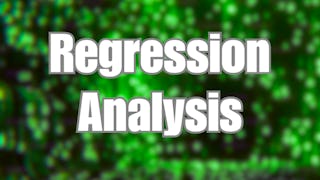This is the fifth of eight courses in the Google Advanced Data Analytics Certificate. Data professionals use regression analysis to discover the relationships between different variables in a dataset and identify key factors that affect business performance. In this course, you’ll practice modeling variable relationships. You'll learn about different methods of data modeling and how to use them to approach business problems. You’ll also explore methods such as linear regression, analysis of variance (ANOVA), and logistic regression.
通过 Coursera Plus 解锁访问 10,000 多门课程。开始 7 天免费试用。


Regression Analysis: Simplify Complex Data Relationships
本课程是 Google Advanced Data Analytics 专业证书 的一部分
64,810 人已注册
包含在 中
您将学到什么
Investigate relationships in datasets
Identify regression model assumptions
Perform linear and logistic regression using Python
Practice model evaluation and interpretation
您将获得的技能
- Regression Analysis
- Machine Learning
- Analytical Skills
- Business Analytics
- Correlation Analysis
- Predictive Modeling
- Exploratory Data Analysis
- Variance Analysis
- Scikit Learn (Machine Learning Library)
- Probability & Statistics
- Advanced Analytics
- Statistical Hypothesis Testing
- Data Analysis
- Statistical Modeling
- Statistical Analysis
- Supervised Learning
- Python Programming
要了解的详细信息

添加到您的领英档案
27 项作业
了解顶级公司的员工如何掌握热门技能

积累 Data Analysis 领域的专业知识
- 向行业专家学习新概念
- 获得对主题或工具的基础理解
- 通过实践项目培养工作相关技能
- 通过 Google 获得可共享的职业证书

该课程共有6个模块
You’ll begin by exploring the main steps for building regression models, from identifying your assumptions to interpreting your results. Next, you’ll explore the two main types of regression: linear and logistic. You’ll learn how data professionals use linear and logistic regression to approach different kinds of business problems.
涵盖的内容
8个视频3篇阅读材料4个作业2个插件
You’ll explore how to use models to describe complex data relationships. You’ll focus on relationships of correlation. Then, you’ll build a simple linear regression model in Python and interpret your results.
涵盖的内容
9个视频8篇阅读材料5个作业5个非评分实验室
After simple regression, you’ll move on to a more complex regression model: multiple linear regression. You’ll consider how multiple regression builds on simple linear regression at every step of the modeling process. You’ll also get a preview of some key topics in machine learning: selection, overfitting, and the bias-variance tradeoff.
涵盖的内容
10个视频4篇阅读材料5个作业3个非评分实验室2个插件
You’ll build on your prior knowledge of hypothesis testing to explore two more statistical tests: Chi-squared and analysis of variance (ANOVA). You’ll learn how data professionals use these tests to analyze different types of data. Finally, you’ll conduct two kinds of Chi-squared tests, as well as one-way and two-way ANOVA tests.
涵盖的内容
9个视频3篇阅读材料4个作业3个非评分实验室
You’ll investigate binomial logistic regression, a type of regression analysis that classifies data into two categories. You’ll learn how to build a binomial logistic regression model and how data professionals use this type of model to gain insights from their data.
涵盖的内容
8个视频4篇阅读材料5个作业3个非评分实验室
You’ll complete an end-of-course project by building a regression model to analyze a workplace scenario dataset.
涵盖的内容
5个视频10篇阅读材料4个作业6个非评分实验室
获得职业证书
将此证书添加到您的 LinkedIn 个人资料、简历或履历中。在社交媒体和绩效考核中分享。
位教师

提供方
从 Data Analysis 浏览更多内容
 状态:免费试用
状态:免费试用 状态:免费试用
状态:免费试用Johns Hopkins University
 状态:免费试用
状态:免费试用Google
 状态:免费试用
状态:免费试用University of Colorado Boulder
人们为什么选择 Coursera 来帮助自己实现职业发展




学生评论
572 条评论
- 5 stars
81.56%
- 4 stars
10.26%
- 3 stars
4.34%
- 2 stars
1.73%
- 1 star
2.08%
显示 3/572 个
已于 Jul 12, 2023审阅
Great course! Especially the statistical touch in it
已于 Apr 13, 2023审阅
very good course, but this course is the most difficult for me
已于 Apr 23, 2024审阅
too good excellent don't hesitate to buy this course
常见问题
Organizations of all types and sizes have business processes that generate massive volumes of data. Every moment, all sorts of information gets created by computers, the internet, phones, texts, streaming video, photographs, sensors, and much more. In the global digital landscape, data is increasingly imprecise, chaotic, and unstructured. As the speed and variety of data increases exponentially, organizations are struggling to keep pace.
Data science and advanced data analytics are part of a field of study that uses raw data to create new ways of modeling and understanding the unknown. To gain insights, businesses rely on data professionals to acquire, organize, and interpret data, which helps inform internal projects and processes. Data scientists and advanced data analysts rely on a combination of critical skills, including statistics, scientific methods, data analysis, and artificial intelligence.
A data professional is a term used to describe any individual who works with data and/or has data skills. At a minimum, a data professional is capable of exploring, cleaning, selecting, analyzing, and visualizing data. They may also be comfortable with writing code and have some familiarity with the techniques used by statisticians and machine learning engineers, including building models, developing algorithmic thinking, and building machine learning models.
Data professionals are responsible for collecting, analyzing, and interpreting large amounts of data within a variety of different organizations. The role of a data professional is defined differently across companies. Generally speaking, data professionals possess technical and strategic capabilities that require more advanced analytical skills such as data manipulation, experimental design, predictive modeling, and machine learning. They perform a variety of tasks related to gathering, structuring, interpreting, monitoring, and reporting data in accessible formats, enabling stakeholders to understand and use data effectively. Ultimately, the work of data professionals helps organizations make informed, ethical decisions.
Large volumes of data — and the technology needed to manage and analyze it — are becoming increasingly accessible. Because of this, there has been a surge in career opportunities for people who can tell stories using data, such as senior data analysts and data scientists. These professionals collect, analyze, and interpret large amounts of data within a variety of different organizations. Their responsibilities require advanced analytical skills such as data manipulation, experimental design, predictive modeling, and machine learning.
更多问题
提供助学金,



